When looking for a restaurant credit card processor, merchants should consider providers that offer a compatible range of payment services and scalability without breaking the bank.
6 Best Credit Card Processing for Restaurants
This article is part of a larger series on Payments.
The best credit card processing for restaurants will vary depending on your company’s size and business model. In general, you will want a payment processor that offers the most versatility, is compatible with multiple popular POS systems, offers chargeback protection, and has competitive rates for restaurants of all sizes.
We evaluated over a dozen providers to give you six of the best restaurant credit card processing companies for small business to date:
- CDGcommerce: Best overall and most versatile restaurant credit card processor
- Stripe: Best for online food ordering and delivery
- Payment Depot: Cheapest fees for small, established restaurants
- Stax: Best value-for-money for midsize and full-service restaurants
- Square Payments: Easiest setup for small and startup restaurants
- Helcim: Best for restaurants that invoice, like catering services and banquet halls
Restaurant Payment Processors Compared
Looking for a great restaurant POS system with built-in payment processing? Many restaurant POS systems offer their own payment processing. Square, which is on our list, is one of them. Others we recommend are Lightspeed, Toast, and TouchBistro. Check out our list of best restaurant POS systems for more options and information.
CDGcommerce: Best Overall Restaurant Payment Processors

Pros
- Robust chargeback monitoring
- Multiple subscription types support a variety of restaurants
- Month-to-month memberships with no cancellation fees
- 24/7 year-round US-based customer service
Cons
- Locking in best rates requires paying monthly fees annually
- Amex cards incur additional fees
- Does not support businesses selling CBD products
- $25 chargeback fee (though refunded if you win the chargeback dispute)
Versatile payment processing is what makes CDGcommerce stand out among other restaurant payment processors in this list. This merchant services provider offers three different subscription types to support restaurants of all sizes. Mom-and-pop restaurants with low sales volumes can get simple flat-rate pricing, while high-volume restaurants can get competitive interchange-plus transaction fees.
CDGcommerce uses TSYS as its back-end processor. This network is compatible with hundreds of POS systems, including popular restaurant systems like TouchBistro, Revel, Lightspeed, Lavu, and Aloha. However, it says its preferred system is HarborTouch, followed by FuturePOS, POSitouch, and Restaurant Manager. You will also find PastePay, Vital, and Echo POS endorsed on the CDGCommerce website.
Back-end processor: One of several companies that connect credit card brands to banks. The major back-end processors in the US are TSYS, Worldpay, Chase Paymentech, Elavon, and Fiserv. Most payment processors and merchant service providers use at least one of the major back-end processors to facilitate credit card transactions.
Based on our restaurant credit card processing criteria, CDGcommerce earned 4.43 out of 5. It received high marks for its payment flexibility, month-to-month memberships, and comprehensive chargeback support. The system lost significant points in account features and pricing because it charges an extra fee for American Express transactions (which many payment processors do) and does not offer same-day deposits, among others.
Flat Rate Plan: Best for small cafes, food trucks, and concessions that process less than $10,000 per month
- Monthly fee: $0
- In-person transactions: 2.75% + 30 cents
- Mobile transactions: 2.75% + 30 cents
- Online transactions: 2.9% + 30 cents
- Keyed-in transactions: + 0.15%
- Amex surcharge fee: + 0.25%
Interchange Plus* Plan: Best for small to medium full-service restaurants and coffee shops that process between $10,000 and $200,000 per month
- Monthly fee: $0
- Retail transactions: Interchange + 0.25% + 10 cents
- Online transactions: Interchange + 0.30% + 15 cents
- Nonprofit transactions: Interchange + 0.20% + 10 cents
*Since interchange rates are set by the card brands, your overall fees for different card types (like Amex) will vary.
Wholesale Plan: Best for high-volume restaurants, restaurants with high check averages, or multi-unit restaurant groups
- Monthly fee: $49–$199
- Transaction fees:
- Basic ($25,000 monthly sales limit): Interchange + 10 cents
- Standard ($75,000 monthly sales limit): Interchange + 10 cents
- Plus ($200,000 monthly sales limit): Interchange + 7 cents
- Premium (Unlimited monthly sales): Interchange + 5 cents
Walker 2.0 | DejaVoo Z11 |
|---|---|
 | 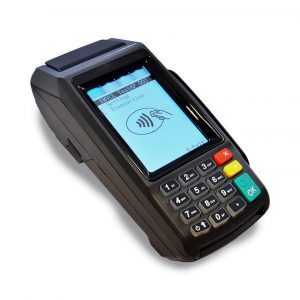 |
$65 | $79/year |
Bluetooth, EMV compatible tap and chip reader for mobile | Wi-Fi connectivity, touch screen, EMV + NFC payments, built-in printer |
Another aspect that sets CDGcommerce head and shoulders above its competitors is its chargeback monitoring tools. If chargebacks are a major concern for your restaurant, you’ll love CDGcommerce’s active chargeback monitoring and robust chargeback assistance. It also refunds chargeback fees if you win the dispute.
Did you know? Chargebacks and “friendly fraud” have increased as restaurants expand their ecommerce operations.
CDGcommerce’s standout features include:
- Chargeback monitoring: In case of a chargeback, CDGcommerce emails you immediately. Its customer service team will help you compose your response to the card brand to ensure you present the strongest case possible. Stripe also has chargeback monitoring, but charges extra for its advanced tools.
- Collections support: If your restaurant does private events or catering, a chargeback dispute can cost you hundreds to thousands of dollars. CDGcommerce’s collections arm will attempt to get back some of the funds, despite losing a chargeback dispute. You will receive 50% of what it collects and pay nothing. It is the only provider on this list with such a feature; however, Square simply covers chargeback disputes up to $250 per month.
- Flexible payment options: CDGcommerce offers a great range of restaurant-specific tools. It integrates with popular gateways, like Authorize.net, PayPal Payflow Pro, and Braintree. It also has its own mobile app for accepting payments directly (although this is not a POS system but a simple payment app). You can also create a case. Stripe offers similar versatility for payment gateways.
- Quick approvals: You can apply for a CDGcommerce account through its sales team, and approvals only take one to three business days. This is pretty fast for the industry, but if you need to start taking payments immediately, check out Square or Stripe.
- No cancellation fees: Like with most of the payment processors on our list, you can stop using CDGcommerce at any time without incurring a cancellation fee. If your business grows or slows or your needs change, you are not tied to a long-term contract.
Stripe: Best for Online Orders, Delivery & Ghost Kitchens

Pros
- Free merchant account
- Extremely good for integrations
- 24/7 support
- Works with popular POS software
Cons
- Complex installation process
- No native POS
- May need an API to integrate into your POS system
- Add-on cost for some payment methods
If you run a food meal service, small catering business, or ghost kitchen that takes direct online orders (ghost kitchens that only use third-party platforms don’t need a processor), then Stripe is your best option. Stripe made it to our roundup of the best online payment and credit card processors as the best choice for online payment processing because it is highly customizable and integratable. Like Square, merchants only need to sign up and skip the approval process.
While Stripe is known for being developer-friendly, there are payment methods that don’t require coding skills. It took me only minutes to sign up for my own Stripe account, and it didn’t take me long to get a hang of creating payment links. However, if you have webmaster or programming experience, then Stripe’s powerful tools will thrill you. You can even create your own custom POS system if you wish.
Overall, Stripe earned 4.28 out of 5 on our rubric. Its pricing is transparent and competitive (though slightly more expensive than Square), and it has a great range of online tools ideal for restaurant credit card processing, including top-rate fraud monitoring and chargeback support. It also offers customer 24/7 support—something Square lacks—but lost points for limited in-person tools and ease of use. Learn why Stripe is often compared to Square.
Stripe, like Square, offers flat-rate payment processing and volume discounts for larger sales. However, Stripe’s rates are more complex than most on our list because it sometimes charges additional transaction fees for services instead of monthly fees.
- Monthly fee: $0–$10
- In-person swipe, dip, touch: 2.7% + 5 cents
- Online: 2.9% + 30 cents
- Keyed-in fee: 3.4% + 30 cents
- Instant payouts: 1%
Additional tools:
- Custom domain for checkout page, billing: $10 per month
- Billing/recurring payments: 0.5%–0.8%
- Invoicing: 0.4%–0.5%
- Automatic tax calculations: 0.5% (not needed if your POS does this)
- Revenue reporting: 0.25% of volume
- Sigma reporting and analysis: Starting at 2 cents per charge
Stripe Reader M2 | BBPOS WisePad 3 | BBPOS WisePOS E |
|---|---|---|
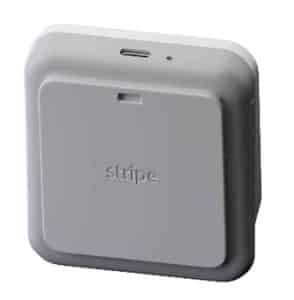 |  |  |
$59 | (Not available for US merchants) | $249 |
Stripe's newest Bluetooth-enabled card reader that accepts EMV chip, contactless, and swipe payments. | EMV chip & contactless payments, built-in PIN pad, Bluetooth connectivity | EMV chip and contactless payments, Wi-Fi connectivity, 5” touch screen display |
Sign up for a Stripe merchant account to purchase card readers from the dashboard.
Stripe’s major strength is its ability to provide a range of customization options. This gives restaurants the opportunity to create a better checkout experience for each customer. Simple customization tools are available for merchants that lack access to coding skills.
- Online ordering: It’s easy to accept online orders with Stripe’s customizable checkout page, which can take one-time orders or subscriptions. Combined with Stripe Billing, you can set up payments for your meal service. If you already have an ordering site, Stripe Elements lets you customize the payment section. Accept any of 18 different payment methods, for versatility that few on our list offer.
- Easy integrations: Stripe integrates with over 1,000 programs, making it the most versatile of all the payment processors on our list. Unfortunately, it doesn’t integrate with many POS systems, though it works with Lightspeed, can handle online payments for Clover via API integration, and processes e-gift cards for Toast. Nonetheless, it offers powerful APIs with excellent documentation and 24/7 support to help you connect Stripe to your software.
- Social and website selling: With Stripe Payment Links, you can add a payment page that works anywhere online. This is great for social selling, like if you want to offer catering gigs or snack boxes from your Facebook page. Payment Links requires no coding. You’re notified by email or on the dashboard when a sale is made. Square and Stax have payment link capability, but the others require a third-party service.
- Fraud Prevention: Like CDGcommerce, Stripe protects you from chargebacks; however, it does so by fighting fraud in the first place. Stripe Radar uses machine learning and the data from billions of Stripe transactions and data from other partners to detect false accounts quickly. The main program is built into Stripe and includes free with a regular account. Stripe also has ID verification tools for detecting fake accounts.
Payment Depot: Best for Small, Established Restaurants

Pros
- Extensive POS integrations
- No contract required
- Offers equipment reprogramming
- No markup on transaction fees
Cons
- Limited to businesses with up to $20,000 in sales volume per month
- Lacks option for same-day funding and next-day funding
- Hardware pricing requires a custom quote
- Exclusive to US merchants
Since its acquisition, Stax has been slowly restructuring Payment Depot to better cater to smaller merchants. Its latest plan update leaves this provider with a single subscription fee of $79 for businesses that sell up to $21,000 per month—but with the same wholesale interchange rates and set of payment tools available to Stax. Payment Depot costs $20 less than Stax in monthly fees, which makes it easy for merchants to know which provider to work with to maximize their savings.
Overall, Payment Depot will be a good fit for established restaurants that have grown beyond a $10,000 monthly steady sales volume but can go without advanced tools, such as one-click shopping cart setup and advanced QuickBooks integration. It also doesn’t hurt that merchants are guaranteed a seamless migration process once your business is ready to upgrade.
In our evaluation, Payment Depot earned an overall score of 4.25 out of 5. While it offered lower subscription fees, we are looking for scalability that doesn’t require a different provider. So, the limited plan and lack of optional add-on functions for growth still affected Payment Depot’s scores.
Since our last update, Payment Depot subscriptions have been narrowed down to a single plan and limited to a sales volume of $250,000. This matches Stax’s latest subscription plan updates, except it costs $20 more ($99/month), and Stax merchants have access to more advanced add-on features.
- Monthly fee: $79
- Annual sales volume limit: $250,000 ($21,000 per month)
- In-person transaction fee: Interchange + 8 cents*
- Card-not-present transaction fee: Interchange + 18 cents*
*Transaction rates based on received quotes; rates may vary at Stax’s sole discretion
SwipeSimple B250 | SwipeSimple Terminal | Poynt Smart Terminal |
|---|---|---|
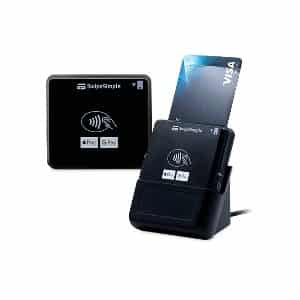 | 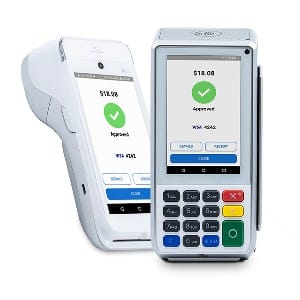 | 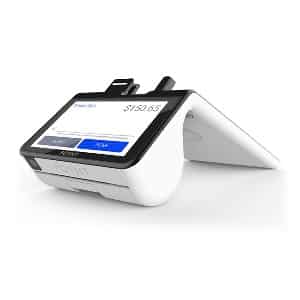 |
Mobile or Countertop Tap, Dip, and Swipe Reader | Cloud-based tap, dip, swipe, or PIN-enabled card reader | Mobile POS Terminal with built in card reader |
Payment Depot regularly appears on our list of the cheapest credit card processors. In addition to competitive interchange-only rates, Payment Depot has historically offered a 90-day money-back guarantee to new customers (call Payment Depot to confirm). Like CDGcommerce, Payment Depot supports a wide range of popular POS systems, particularly Clover.
- All-in-one pricing: Your Payment Depot account includes in-person and online payment tools for a single monthly fee. With a minimal additional markup on interchange fees, Payment Depot is the lowest-cost processor for high-volume restaurants, especially those that need to reduce the costs of processing online payments. It also reprograms your equipment for free—others, like Stripe, will assist but not do this for you.
- Choice of payment gateway: Rather than providing its own gateway, like the others on our list, Payment Depot offers you a choice of popular gateways for free: Authorize.net or SwipeSimple, usually. These come with added benefits like a virtual terminal.
- 24/7 customer support: Like CDGcommerce, Payment Depot offers customer support via phone and email 24 hours a day. Customer reviews frequently mention Payment Depot’s speedy response time and supportive staff. This is great news for restaurant managers who need to resolve payment problems when sending the Saturday night credit card batch.
- Level 2 and Level 3 credit card processing: Like Stax, Payment Depot offers Level 2 data processing—something you would want in the best credit card processing for restaurants if you cater to corporate events.
Stax: Best Value-for-Money for Midsize & Full-service Restaurants

Pros
- Hardware-free credit card processing
- Excellent customer service
- Stored payments and recurring billing are a good fit for meal kit programs
- Free terminal or mobile card reader
Cons
- Account approvals can be lengthy
- Not a good fit for small operations that process less than $10,000 per month
- API integration requires a Pro or Ultimate Plan
- Same-day and next-day funding with fee
Stax (formerlyFattmerchant) offers wholesale interchange-plus pricing, with a monthly fee that includes other benefits for businesses. The system provides a wide range of payment processing tools, from at-the-counter and online payments to table-side, curbside, and cash-on-delivery methods. And with wholesale interchange rates, Stax is certainly the best value-for-money option for full-service restaurants that process over $21,000 in sales a month.
Like any traditional merchant account, Stax has an application process in place that takes 24 to 48 hours to approve on average. You need to show previous processing statements, making it harder for new restaurants to apply. For fast and easy approvals, small independent restaurants are better off with Square or Stripe.
Stax earned 4.19 out of 5 in our evaluation. We usually look for simple, transparent pricing in our list of best merchant services for restaurants (or for any industry), and Stax fits the bill with its straightforward fee structure. However, Stax could have scored higher if it offered faster funding and better chargeback support (like CDGCommerce).
With Stax, merchants only pay a monthly subscription fee in exchange for wholesale interchange-plus rates on their transactions. There are no cancellation, statement, or batch fees. It does not add a percentage markup, so there is no complicated math to figure out what you’ll pay for each transaction.
Stax offers two small business plans (plus custom rates for merchants processing more than $500,000 annually), and monthly rates vary depending on sales volume. However, the transaction fees are the same for all tools and for all credit cards. It does not have an extra fee for American Express like CDGcommerce.
- Monthly fee:
- Annual sales volume of up to $250,000: $99
- Annual sales volume from $250,000 to $500,000: $199
- In-person transaction fee: Interchange + 8 cents*
- Card-not-present transaction fee: Interchange + 18 cents*
*Transaction rates based on received quotes; rates may vary at Stax’s sole discretion.
On the other hand, Stax charges extra for its custom branding for invoices and shopping carts (although access to one-click shopping cart setup with catalog management is now available to all plans). It also has add-ons for QuickBooks Online Pro sync, terminal protection, next-day funding, and digital gift cards.
If you qualify for Level 2 payment processing (generally for business-to-business (B2B) payments), Stax can arrange lower interchange rates. However, this is also a paid add-on.
Stax’s main mobile card reader is programmed by BBPOS (usually costs $59), but it also works with several card terminals and POS hardware with built-in card readers. It’s possible to get your first card reader or terminal for free, but you will need to contact Stripe for terms and conditions. Stax can also help you reprogram one of your current card readers if you so wish.
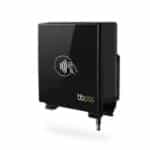 Stax Pay Mobile Reader The Chipper™ 2X BT is an EMV-compliant, Bluetooth-enabled swipe, dip, and tap reader for mobile or on-site payments. |
 |
 Dejavoo Systems' countertop terminals Countertop, POS or Wi-Fi connected card reader |
Stax’s easy pricing structure and free card reader or terminal is complemented by its ability to integrate with a wider range of restaurant POS systems (through TSYS). We especially like the Text2Pay tool for home deliveries, but if you supply larger clients, you can send invoices and even recurring payments.
- Hardware-free credit card processing: Stax mobile payments now features an option to process card payments without additional hardware attached to your mobile device. Simply use your smartphone camera to scan an image of your customer’s credit card and have them input their CVC when prompted to confirm the purchase. No other provider on this list has this feature, although Stripe and Square offer a tap-to-pay method with an iPhone.
- Chargeback support: Like CDGcommerce, Stax will notify you when a customer initiates a chargeback dispute. You can organize your supporting documents and send your response to your Stax dashboard. Though these tools are less robust than what CDGcommerce offers, if chargebacks are rare in your business, they may be all you need.
- Text2Pay mobile payments: You can send payment requests to customers directly from a smartphone and receive payment via SMS text. This is another unique restaurant credit card processing feature for Stax that’s handy for delivery-heavy establishments.
- Phone payments: While Stax charges for a virtual terminal and its online solution, it does not charge more for keyed-in payments. Square, by contrast, charges almost a full percentage more than its swipe payments. If your POS or ecommerce tool already has a virtual terminal, this makes it cost-effective for phone orders.
- Stax Connect: For established large restaurants, Stax can provide a highly customized setup through APIs that can develop everything—from preferred payment methods and advanced analytics to back office tools integration. The API expands your payment tools with custom split payments, level 2 processing (for B2Bs), dispute management function, card updater, and even integrated compliant surcharging.
Square Payments: Easiest Setup for Small & Startup Restaurants

Pros
- Free built-in POS and online ordering site
- No surcharge fees for different card types
- Waived chargeback fees ($250/month)
- Signup only, no approval required
Cons
- Flat-rate fees are higher compared to interchange plus or wholesale pricing
- Extra cost for same-day funding
- Chargeback support is limited
- Exclusive to Square POS users
Small businesses, including merchants just starting up their restaurant, will benefit the most from an all-in-one solution like Square. Its basic restaurant POS system is free and already comes with an incredibly easy-to-use payment processor that operates on POS terminals and mobile devices. You also get a website builder and magstripe card reader for free.
Best of all, there is no application process or approval. Small restaurants don’t need to complete invasive questionnaires or wait days for account approval; you can start accepting Square payments within the day. All you need is a card reader and a Square account that connects to your bank account.
Square earned an overall score of 4.16 out of 5 in our evaluation, with high marks for ease of use and affordability. It also offers excellent online and in-person payment processing tools, topping our list of the best merchant services for small businesses. However, only users of Square POS plus the lesser-known SalesVu and Koomi POS, can integrate Square into their POS.
Square is a flat-rate processor, meaning that no matter the card or interchange rate, you pay the same. It’s a great choice for startup restaurants with low-volume sales, especially since there are no monthly fees, and you get basic POS, invoicing, online payments, and a virtual terminal for free.
The processing rates are:
- Monthly processing fee: $0
- In-person card payment: 2.6% + 10 cents
- Invoice and online card payment: 2.9% + 30 cents
- Keyed-in, card-on-file, and recurring: 3.5% + 15 cents
- Buy Now Pay Later: 6% + 30 cents (per card payment with Afterpay)
- Same-day funding: +1.75%
If your restaurant processes more than $250,000 annually, you can contact Square directly for a custom quote to lower those fees.
Square offers many advanced services:
- Square for Restaurants: $0–$60 per month
- Square Online: $0–$79 per month
- Invoicing: $0–$20 per month
- Square Team Management: $0–$35 per month
- Square Loyalty: $45–$105 per month (depending on loyalty visits)
- Square Marketing:
- Email: $15–$40 per month
- Text: $10 per month + $10–$125 per month
- Square Payroll: From $35 + $5 per employee per month
Get detailed Square pricing with our guide.
Magstripe Reader | Contactless & Chip Reader | Square Terminal | Square Stand Mount for iPad |
|---|---|---|---|
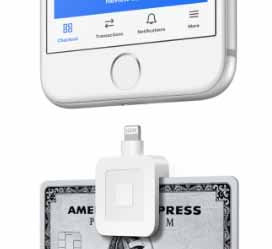 |  |  |  |
Free | $49 | $299 or $27 x12 mos. | $149 or $14 x12 mos. |
Mobile swipe card payments | Mobile or on-site tap and chip reader | Tableside card readers | Self-service built-in card reader |
Square manages credit, debit, and mobile wallet payments directly from bank to merchant without using a back-end processor like TSYS. However, this means it’s not as compatible with other POS systems. It offers its own excellent POS system, Square for Restaurants, plus a suite of online tools and a mobile app with a full POS. You can use its own hardware or an iPad or smartphone (Android or iOS).
- POS compatibility: You can use Square Payments on the Square for Restaurants POS, which offers a free baseline system that operates on iPads or Square hardware. Square Payments is also compatible with TouchBistro and SalesVu if you prefer a different POS layout. It integrates with Koomi POS for quick-service restaurants.
- Free online ordering site: Square users get access to a free online ordering site that integrates with the Square for Restaurants POS. You can accept online orders for pickup or delivery and accept online payments for online orders. Others offer online ordering, but it may not integrate as easily as Square does to its POS.
- Free invoicing tools: Though not as affordable as Payline Data, if your restaurant does private events or off-site catering, Square lets you send professional-looking invoices for deposits and payments directly from the dashboard.
- Business services: Unlike the other payment processors on our list, Square offers a complete offering of business services, including bank accounts, loans, payroll, and even benefits. If you want to have a full fintech system that works together with ease and can grow with you, Square is a top choice.
Helcim: Best for Restaurants that Invoice, Like Catering Services

Pros
- Interchange-plus pricing and low account fees
- Automatic discounts
- Zero-cost payment processing option
- Free invoicing, recurring billing, virtual terminal, and website builder
Cons
- Expensive credit card payment processing hardware
- Surcharge for Amex transactions
- Limited back-office integrations
- Automatic discounts only starts from sales of over $50,000/month
Helcim is a versatile merchant services provider that stands out as the only product on our list that offers automated discounts. This means merchants are not bound by sales volume limits and will not have to apply for better transaction rates as the business grows. There are no monthly account fees, nor does it charge extra for its other payment services like invoicing, recurring billing, website builder, and virtual terminal.
Restaurants that cater will find Helcim most ideal for its invoicing features. Aside from being entirely free, the invoicing service supports one-time, recurring, and partial payments, as well as ACH and over-the-phone payment methods. It even offers smart zero-cost processing that adapts based on the merchant’s location and card brand.
Helcim joins our list of highly versatile restaurant credit card processors with a score of 3.90 out of 5, replacing Payline Data. It earned extra points for POS and payment features because it comes with both proprietary and multiple POS software integrations. However, Helcim offers very limited back-office integration and charges extra for Amex transactions. The setup is fast, but the actual merchant application can take some time to approve. Its payment terminals are quite expensive too.
Helcim does not charge any monthly service fee for using its payment processing tools and offers a unique interchange plus automated discount pricing method. There are no setup, application, or cancellation fees, and offers a month-to-month contract. However, it has one of the most expensive mobile credit card readers in the industry.
Since our last update: Helcim has made changes to its transaction fees table. While still offering interchange plus rates, discounts now start for sales volume above $50,000 (previously $25,000 per month). Actual rates have increased from the previous 0.10% + 5 cents to 0.3% + 8 cents for card-present, and 0.20% + 10 cents to 0.50% + 25 cents for card-not-present transactions.
Monthly Credit Card Volume | In-person Rates | Keyed-in & Online Rates |
|---|---|---|
$0–$50,000 | 0.40% + 8 cents | 0.50% + 25 cents |
$50,001–$100,000 | 0.35% + 7 cents | 0.45% + 20 cents |
100,001–$500,000 | 0.25% + 7 cents | 0.35% + 20 cents |
$500,001–$1,000,000 | 0.20% + 6 cents | 0.25% + 15 cents |
$1,000,001+ | 0.15% + 6 cents | 0.15% + 15 cents |
Other payment processing fees:
- Surcharge fees for American Express: 0.10% + 10 cents
- ACH transactions: 0.5% + 25 cents (capped at $6) per transaction
- Chargeback fee: $15 (reimbursable)
Since our last update: Helcim has introduced its new stand-alone smart terminal. It comes with a built-in, customizable POS feature, inventory and customer management tools, and receipt printer.
Helcim offers two payment terminal options—both mobile. The standard card reader can be used along with a desktop, tablet, or smartphone, while the smart terminal is a stand-alone option perfect for table-side ordering and payments.
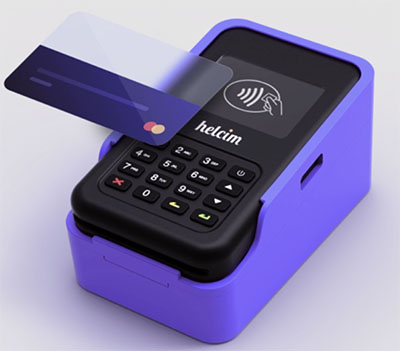 Helcim Mobile Card Reader $109 | 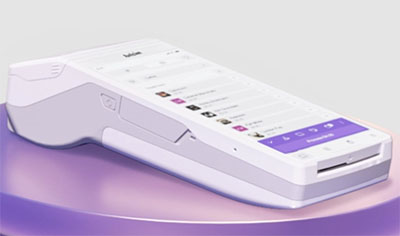 Helcim Smart Terminal $349 |
|---|---|
|
|
In addition to competitive interchange-plus fees, Helcim integrates with several ecommerce platforms—Shopify, WooCommerce, BigCommerce, Magento, and more. If you want a sharp-looking online ordering site that combines catering services, takeout and delivery orders, and merchandise, these integrations provide you with a lot more flexibility than your basic online ordering system.
Helcim’s standout features include:
- Invoicing: Helcim allows you to send customized invoices online for free. Customers can then make payments via credit card, or ACH from the payment link included on the invoice or over the phone from the virtual terminal. Helcim also allows you to accept partial payments that work well for catering services.
- ACH payment processing: Helcim can also accept local and international ACH payments. There are no monthly fees for using this service, and the transaction fees are significantly lower. This payment method is available for customers paying with an invoice, online, over the phone, with a recurring billing setup, and even from a payment link.
- Smart zero-cost processing: Merchants who sign up for credit card and ACH processing service also come with the option to pass on their processing fees to customers in the method that’s legal to their state and card brand. This can be done with a simple toggle button on the payments settings.
- Point-of-Sale app: Helcim offers a proprietary POS software that can be used on a desktop, tablet, and on a smartphone. It is also the same POS software built into its new stand-alone smart terminal. The software comes with inventory, CRM, and reporting features, is simple to set up and easy to use. It may not be dynamic enough for busy fast food or sit-down restaurants, but caterers would definitely find the system useful.
- Website and ecommerce integrations: The Online Checkout is Helcim’s own website builder. It allows merchants to create a fully functional, mobile and desktop-optimized ecommerce store from product and inventory management, shipping tools, tipping and discounts, cart review, and reporting features. It also provides a customer login system for regular customers that opt to store their credit card or bank details for faster transactions.
How to Choose the Best Credit Card Processor for Restaurants
The best credit card processing for restaurants is versatile and flexible. It offers the payment methods most often seen in food services, with best value-for-money pricing.
1. Make a list of restaurant credit card processors that work best with your business model.
Not all restaurants are the same. Some restaurants may want to accept credit card payments in-store, while others want a way to accept credit card payments online. Food trucks, caterers, and pop-ups will likely prefer a mobile payment method. To get you started, check out our recommendations for best merchant services, mobile, and online payment processor options.
Pro tip: Several restaurant POS systems offer their own payment processing that works on their systems. We recommend Toast, Lightspeed, Square, and TouchBistro for restaurant payment processors with their own POS system.
2. Compare restaurant-specific payment tools available.
Narrow down your list by evaluating the kind of payment tools you need for your restaurant. If you have a large sit-down-style restaurant, you may need a stand-alone terminal for tableside ordering and payment methods. Caterers may be looking for an invoicing feature and the ability to accept partial payments. If possible, find providers that offer your preferred payment services without extra monthly fees or are not gated in higher subscription plans.
3. Compare the monthly and transaction fees.
Focus on the best value for your money. The lowest-priced or free payment processor may not always be the best choice for your business. Although there are many providers out there that can offer zero monthly fees, larger restaurants may save more by signing up for a monthly subscription with wholesale interchange rates. Visit our recommendation for cheapest credit card processors.
Get ready to sign up for a merchant account. If you need help, enter your email to download our free merchant account application guide to help you get started.
How We Evaluated Payment Processors for Restaurants
We compared several popular restaurant merchant account providers based on what’s important to independent restaurants, including cost, chargeback protection, and compatible POS systems. We also considered our retail and restaurant experts’ personal evaluations of each software, alongside customer reviews from popular review sites.
CDGcommerce emerged as the best restaurant credit card processing company with an overall score of 4.43 out of 5. Based on our experience working in and with independent restaurant businesses that rely on payment processors, CDGcommerce is also one of the top tools that we personally recommend.
Click through the tabs below for a full breakdown of our scoring criteria:
20% of Overall Score
With all the new payment technology available, like zero cost and digital wallets, pricing is now focused more on the best value-for-money. We look for processors that offer locked-in rates, transparent pricing, volume discounts, and no or low chargeback fees. We also gave premium points for month-to-month contracts and contracts with no cancellation fees, since a restaurant’s needs can change over time. Square takes the lead with 4.75 out of 5.
30% of Overall Score
Most restaurants run their transactions through a POS system, so we looked for processors compatible with multiple systems. We also looked for online payment tools, tableside card readers, and the ability to process in-person payments in the field. CDGcommerce earned a perfect score for its breadth of payment methods and range of POS integrations.
30% of Overall Score
In addition to general features like one-day deposits and chargeback monitoring, we also considered features important to restaurants, like after-hours customer support and customer data analysis. We were very discerning in this section. Stripe, with 4.25, was the top contender.
20% of Overall Score
This score combines our judgment of price, ease of use, and feature set with the reviews of real-world users. Square earned a perfect score. CDGCommerce and Helcim did well, scoring 4.38 out of 5. Payment Depot followed with 4.06, while Stripe and Stax trailed with a score of 3.75 out of 5.
Restaurant Payment Processors Frequently Asked Questions (FAQs)
In truth, any payment processor (or merchant account and gateway) can work for a restaurant, since it generally facilitates payment via credit, debit, and so on. However, the best restaurant payment processors integrate easily with your restaurant POS and offer competitive rates, as well as tools for online and phone-in ordering.
Not necessarily. Many general-use payment processors work just fine with restaurant systems. If you already have a payment processor or merchant account you are comfortable with, then you should check that it will integrate with your restaurant POS.
Established restaurants or existing restaurants expanding into new locations will benefit from shopping for the best rates. If your restaurant is high-volume or has a high check average (over $40 per person), you’ll also benefit from shopping around for the best rates.
A good processing rate for your restaurant is one that allows you to accept credit, debit, and mobile wallet payments while still turning a profit. Every restaurant is different, so a good processing rate for a mom-and-pop breakfast spot with low check averages will likely be higher than a good processing rate for a high-volume restaurant that serves three meals a day.
It’s important to remember that the rates you are quoted as a new business will not be the rates you pay forever. As your sales grow, you will have a documented history of your sales volume and check average, so you can negotiate lower rates with your processor or shop for a new one.
The best way to get low processing rates for your restaurant is to process as many transactions as possible in person. Avoid manually entering credit card payments. If a customer’s card is declined, avoid multiple swipes; instead, request a different form of payment. Get a signature with every transaction, and update your card readers to EMV-compliant and point-to-point encryption (P2PE) enabled readers.
After you have been open for a year, use your sales history to get rate quotes from several processors. Even if your POS contract prevents you from switching to a new processor right away, you may be able to use the documented quotes from other processors to negotiate lower rates with your current processor.
Learn more about how credit card processing fees work.
Bottom Line
The best credit card processing for restaurants are not always those that come built-in with POS systems. You may want a restaurant merchant account with better rates or need a payment processor that also works with online orders.
After evaluating over a dozen payment processors, CDGcommerce emerged as the top restaurant payment processing service for its flexible payment plans and wealth of compatible POS systems. It also provides the strongest chargeback protection tools of any system on this list—an absolute must for any restaurant that accepts online or mobile payments. To find the best plan for your restaurant, contact CDGcommerce to get started.




